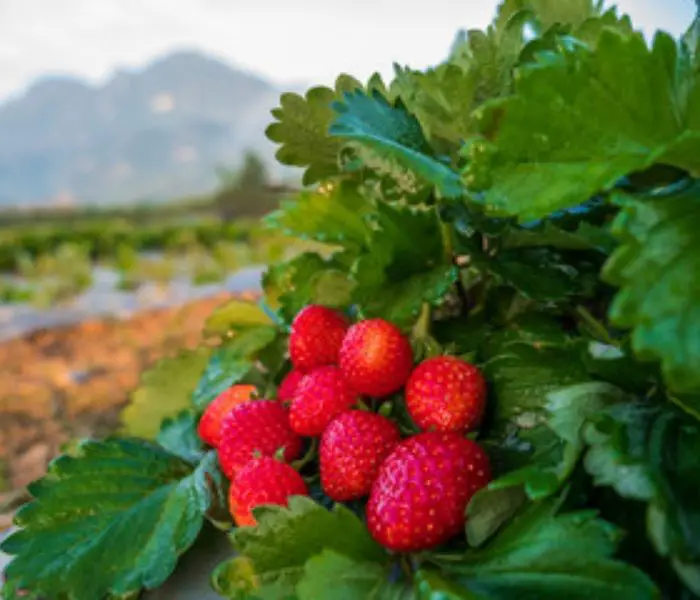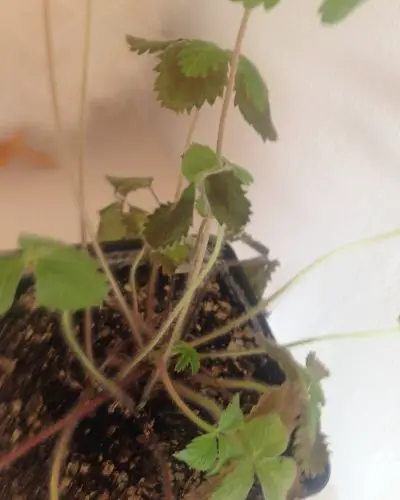Strawberry Plants Leaves Are Turning Brown

Strawberry plants leaves are turning brown, do the strawberry plants need watering? Water is essential for every living thing on earth. Since planet earth consists of plants besides humans and other animals, they do depend on water.
What happens if we overwater our plants? Are there any rules for watering plants? We’re going to find out the answers and myths about watering plants in this discussion.
Strawberry plants are not fond of too many wet surroundings. So, overwatering strawberry plants might result in decaying plant health.
Again, we are aware of that, too dry soil is not also good for plants. So, it is vital to keep proper moisture for the appropriate growth of the plants.
Some of us might be puzzled about the best time of watering a plant. Which is the best time or moment for watering plants? Is it during the day or the afternoon?
The proper timing of watering a plant is an issue of debate. But this depends on various factors as well as moisture or need for water.
Why Strawberry Plants Leaves Are Turning Brown
Why do strawberry plant leaves turn brown? Here we try to find out the common symptoms of Strawberry plants leaves are turning brown that might look like they need for watering:

photo credit: gardening.stackexchange.com

Photo Credit: gardening.stackexchange.com
1. Heat Wilt
Wilting is the situation where plant stem gets weaken and tends to bow down close to the soil. At first sight, it might seem like the plants need water. But sudden wilting might be due to excessive heat at daytime and not for lack of moisture.
At this point, watering the plants won’t help, and instead of helping, the plant root and stem might get rotten due to overwatering.
2. Dry Soil
If the soil is dehydrated from the surface up to an inch, it is must that you water the plants. However, there is a myth that watering plants during sun heat might result in health issues of the plants.
In advanced research from the Puyallup Research and Extension Center at Washington State University has stated that it is merely a concern. Instead, it’s good for plants to have water at sun heat as there is a loss of water due to evaporation.
On the other hand, watering in the morning plays an essential role in avoiding fungal diseases and too much evaporation at direct sunlight.
3. Heat Shock Prevention
Proper watering helps plants to cope up with the sun heat at daytime, but it doesn’t ensure plants survive the intense heatwave. Plants having a good root system and proper source of nutrition recovers themselves naturally after a heatwave. Still, watering plants at daytime might help in surviving heat waves and assist in quick recovery.
4. Slowing down Water loss
It is true that during the daytime due to sun heat, evaporation plays a vital role in plants is losing water. By adding some covering material on the ground, it can be slowed down a bit. Wet rubber or clothes covering the naked surface ends in losing water much slower than usual.
Why Do Plants Need Watering?
Aren’t we familiar with some myths like- plants needed to be watered about an inch daily, or what about, drought-resistant plants don’t need to be watered regularly?
Let’s find out some more facts about watering plants-
Watering an inch:
It is commonly said that plants need watering an inch every day. Well, that is a vague term. Watering plants depend on various other factors, such as- type of plants, type of soil, environment pattern, etc.
For young plants or seedlings, they have new growth of roots that are unable to reach deep soil and ensure a proper water source. For such plants, keeping the soil surface well moisturized is essential.
On the other hand, adult plants or plants with well-established root systems are not that dependent on water from the surface.
Still watering plants with well-established root systems helps in keeping them in good health. Such a supplement also helps plants in fighting excessive heat waves during hot temperatures.
We want to know the best way of watering the plants. We can water plants up to the limit, that the surface soil remains enough moisturized regardless of types of plants.
If we water plants for a short time, it will moisturize the surface but cause plants to adapt the behavior of developing their roots close to soil surface for an available water source. Ultimately that results in roots getting dry quickly during daytime due to evaporation. This will be a bad idea.
Overhead watering plants cause decaying plant health
The best way to water plants is to put water on the soil surface near the roots. Spraying water on plants or leaves will cause much loss of water due to evaporation. Also, that might become a reason of fungal attack on plant leaves.
On the contrary, spraying water on plant leaves might be a great idea at the time of winter or dry season. Dust or other particles might block leaves from performing photosynthesis.
Less watering drought-resistant plants
As we have discussed earlier, new plants have weaker roots, unable to collect water or hold them for long. This habit applies to all types of plants.
So, watering drought-resistant plants at their early growth stage might cause the plants to die due to a shortage of water.
Draught resistance doesn’t ensure that the plant doesn’t need water. Keeping the soil surface well moisturized keeps every plant in good health.
Some Basic Rules of Watering strawberry plants
Strawberry plant leaves are turning brown, shall we water them? What are the basic rules for watering strawberry plants?
Strawberries are perennial plants, which means their roots grow every year and establish themselves throughout the year. Some varieties even don’t produce fruits in the first year of planting.
Spring is considered the most suitable period of the year for planting strawberries. These plants are fond of full sun and require proper nutrition.
Planting an adult strawberry plant is a common practice. The plant needs proper sunlight, and well-moisturized soil is essential.
Now, let’s know how to water strawberry plants!
- Strawberry plants need water like other plants, and it requires intensive care on a hot sunny day. Spraying water over the leaves or fruits might cause fungal diseases.
- Watering strawberry plants in the morning is a good idea. The surface water evaporates by the evening.
- Another critical issue is to keep a barrier between the fruits and soil surface to prevent weeds from growing and causing trouble to the plants.
The FAQs About Strawberry Plant’s Leaves Are Turning Brown
1. Why are the leaves on my strawberry plant turning brown?
Ans: The most commonly brown leaf top is caused by the plant not getting enough water. To prevent the leaves from turning brown, enough watering for plants should be ensured.
2. Should I remove dead leaves from strawberry plants?
Ans: Pruning leaves, cutting dried leaves will be a great idea to maintain good plant health.
3. Is my strawberry plant dying?
Ans: Brown leaves aren’t the sign of strawberry plant dying. Leaves turn brown due to the shortage of proper water supply. Strawberry plants might due to insect attacks, which leads to diseases.
4. Can brown leaves of strawberry plants turn green again?
Ans: Brown part of the leaves indicates the part is dead already; they can’t be turned into green anyways. But watering the strawberry plants properly can prevent more leaves from dying later.
5. How do you know if you are overwatering your strawberry plants?
Ans: We can decide by 5 Signs of overwatering, such as-
- Wet and Wilting-The plant looks wilted, but the soil is well moisturized. As discussed earlier, in this case watering the strawberry plants isn’t the right solution.
- Brown Leaves- If the strawberry plant leaves turn brown and wilt, there is a possibility of overwatering the strawberry plant.
- Edema-The plant stem or leaves or any other parts get swallowed or thick.
- Yellow Falling Leaves- Young leaves of strawberry plants turn in yellow quickly and start falling from trees in a short time.
- Root Rot- Root of the strawberry plants starts getting rotten due to overwatering.
6. How often should strawberry plants be watered?
Ans: During the non-peak growing season, the strawberry plants should be watered at least twice a week to keep the right balance of soil moisture. It is best to water earlier in the day rather than in the evening, so the plants are not set in water for too long.
7. How can I revive a strawberry plant in heat shock?
Ans: Watering the strawberry plant properly will be the best solution. But we need to be careful so that water doesn’t stand for long, that’ll also be harmful to the strawberry plants. Also, we can cover up the soil surface to slow down the evaporation.
Eventually, the plant will start recovering itself in time.
8. How do I revive a dying strawberry plant?
Ans: Let’s follow the steps-
- Repot the strawberry plant in a new pot or location.
- Trimming the strawberry plant leaves.
- Move the strawberry plant to a new location.
- Watering the strawberry plant properly.
- Ensuring proper nutrition for the strawberry plant.
- If not revived, finally wiping off the dead strawberry plant.
9. What is the lifespan of a strawberry plant?
Ans: With proper care, a strawberry plant can live up to 5-6 years.
10. Is it normal for strawberry plants to wilt after transplanting?
Ans: During the movement of a strawberry plant, the roots might get damaged. With damaged roots, it is ubiquitous to show symptoms of wilting. With proper care, after some days, the plant will automatically revive itself.
11. Why are my strawberry flowers dying?
Ans: Strawberry plants get infected by various insects during flowering. Infected flowers might die due to severe infection.
The petals and flowering stems show brown color. Sometimes rot symptoms aren’t expressed till harvesting time.
12. How do you save waterlogged strawberry plants?
Ans: Move the potted strawberry plants to a safe place. In the garden, install a proper drainage system. Instantly pumping the extra water out might help. Waterlogging doesn’t confirm all plants’ death.
13. Should I mist my strawberry plants?
Ans: Misting strawberry plants can help to raise the soil moisture. But we must mist plants only in the morning so that the leaves can become dry before evening.
Misting both sides of the leaves, not just the top, is the best practice. Misting also helps to prevent spider mite infestations.
14. How much water do you use to water a strawberry plant?
Ans: It may take as much as a gallon of water to water a 10 to 12-inch container thoroughly. In the garden, moisture should be present in soil surface up to an inch.
15. How can you tell the difference between overwatering and underwatering a strawberry plant?
Ans: In both cases of overwatering and underwatering, a strawberry plant is almost the same, leaves turn into brown, and the plant wilts. A little difference can be observed.
In case of, overwatering; died brown leaf might become thick and soft. On the other hand, the leaves that died due to underwatering might become hard and dry.
16. What nutrient deficiency causes yellow leaves other than watering deficiency?
Ans: The most common nutrient problem associated with yellow leaves is lack of iron, but yellowing may also be caused by manganese, zinc, or nitrogen deficiencies.
17. Are coffee grounds good for strawberries?
Ans: Coffee grounds for the strawberry garden are simply magnificent due to their acidic pH nature.
18. Do strawberry plants go into shock after transplanting?
Ans: Plant transplant shock is only caused by damage to the plant roots during the transplanting process.
19. How do you know if a strawberry plant is in shock?
Ans: Leaves turn yellow or brown or darken, and they fall off at a slight single touch. Both leaves and stems wilt and dry out. Buds fall or fail to form.
20. Can I reuse soil from a dead strawberry plant?
Ans: You can use the soil from a dead plant. But ensuring proper nutrition and infection should be the top priority.
21. How often should you replace strawberry plants?
Strawberry plants don’t last forever, so you do have to replace them and their soil every few years. Lifespan is two to five years for an average plant.
Bottom Line
We are at the end of our guideline to stop turning brown your loving strawberry plants. I hope now you know how to protect your Strawberry plants leaves are turning brown. Just follow all the facts and methods we describe above to Keep your plants healthy.
Happy Gardening!
Other Plants Health Tips: Types of Worms in Potted Plants








